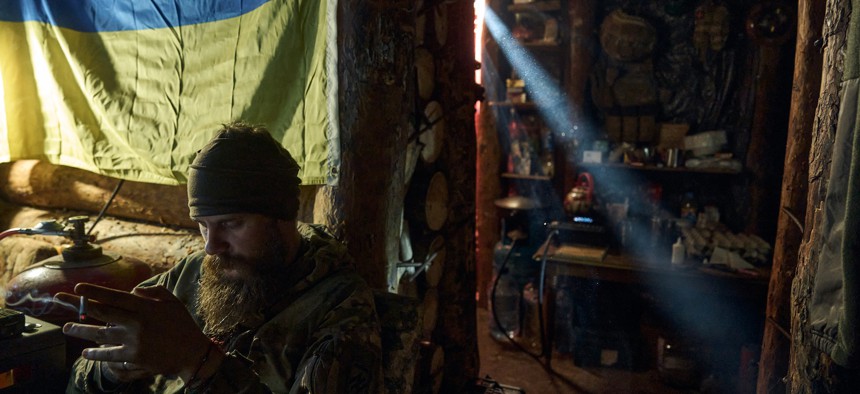
A solider at the company command post near the front line of Kreminna Forest in Ukraine, September 24, 2023. Libkos / Getty Images
What the US military can learn from Ukrainian command posts
Two foreign volunteer soldiers described operations centers in frontline Ukraine, from surviving Russian missiles to managing drone feeds.
The first time a Russian missile hit Nathan Chan’s command post, it stopped short of his position in the basement. The second time a Russian missile hit, he got lucky again. The main charge of the missile failed to detonate.
“We all counted our stars,” said Chan, a former U.S. Marine who fought in Bakhmut, Ukraine, from February 2023 until the city fell to Russia in May.
Experiences like Chan’s running command posts in Ukraine have drawn the attention of the U.S. Army and Marine Corps, which are pursuing sweeping plans to modernize the large operations centers that once defined the wars in Iraq and Afghanistan.
In interviews with Defense One, Chan and another foreign volunteer who worked in a Ukrainian operations center described how technology has drastically changed their work, from making troops more mobile to overwhelming commanders with information.
Thanks to satellite internet connections from Starlink dishes, Ukraine’s staff officers can quickly set up operations centers while simultaneously getting access to large quantities of data, Chan said.
“I don't think people have fully realized how much of a game-changer Starlink has been,” said Chan, who served as a communications officer in the Marine Corps until 2019.
“When I was in the Marine Corps, we basically hauled this huge truck out there, which gave us like four megabits per second,” Chan said. “And now we can plop down a Starlink, for people who don't know how to operate satellite machinery,” providing small units with 100 megabits a second, instantly.
Troops in Ukraine then use Starlink to run a host of commercial technologies, such as secure messaging app Signal and Google Meet, which can stream drone footage from commercial drones. Commercial radios, reconfigured for more security, are an additional means of communication.
Such tools also require no specialized staff to operate, and easily integrate with each other. That stands in contrast to military communications tools, Chan said, which may require specialized staff for each application, from artillery coordination to communications.
“There's a lot of proprietary and non-cooperative information technology systems at work,” in Marine command posts Chan said, a point Army commanders in charge of training have also raised about their own command posts.
There are also vast quantities of data available to Ukraine thanks to commercial technology, said the foreign volunteer who worked in Ukrainian command posts. In addition to multiple drone feeds streaming into operation rooms, Ukrainian commanders can depend on satellite imagery and open source information, he said.
Despite the advances, however, Ukrainian command posts are still vulnerable to attack. Chan’s command post was hit twice, despite it being smaller than U.S. command posts.
Russia can identify posts using a variety of means, he said, including scanning for radio emissions, analyzing satellite maps, spotting clusters of cars with drones, finding clusters of cell phone signals, or even using information from collaborators or spies within the Ukrainian population.
Keeping staff numbers low is important, Chan said. “The more people you bring, it almost exponentially increases your signature,” he said. While the U.S. may be able to protect larger staff headquarters farther from the frontline, the thought of a 200- to 300-person sized command post is now “ludicrous” to him, he said.
The sheer volume of available information also comes with its own problems, both troops said.
For one, Ukraine lacks staff officers trained to work with using all the data they have access to, said the foreign volunteer. Any military would need “essentially an entire trained team of people to process this information in a usable way,” he said.
British think-tank RUSI has similarly identified a shortage of trained staff officers as a key problem for Ukrainian military operations, in part due to the rapid expansion of the Ukrainian military during the course of the war.
The U.S. may also need to rework training to reflect the intensity of modern war, the foreign volunteer said. With command posts subject to strikes and overwhelmed with information, officers as junior as platoon commanders may need to learn to run command posts and coordinate artillery strikes, he said.
Access to technology may also subtly distort the planning process, both said.
For example, Chan recounted how he was able to use mapping software to mark off individual buildings in Bakhmut as they were reported taken by the enemy. However, the buildings were actually held by Ukrainian forces, a mistake that Chan discovered in time. Just because soldiers can make planning documents very precise, Chan said, the data still depends on the information being correct.
Chan also noted that an emphasis on managing battles with basic, commercially-designed software could also have downsides—Signal, for example, is built for security, so it lacks more advanced features for information sharing, he said.
The other foreign volunteer, meanwhile, recounted how some Ukrainian commanders chose targets based on whether they had drone coverage of them, even if the targets were not an immediate threat.
“Instead of killing Russians that are rushing to occupy a critical position in the middle of a fight, they're [killing Russians] smoking in an assembly area several kilometers away,” he said.


